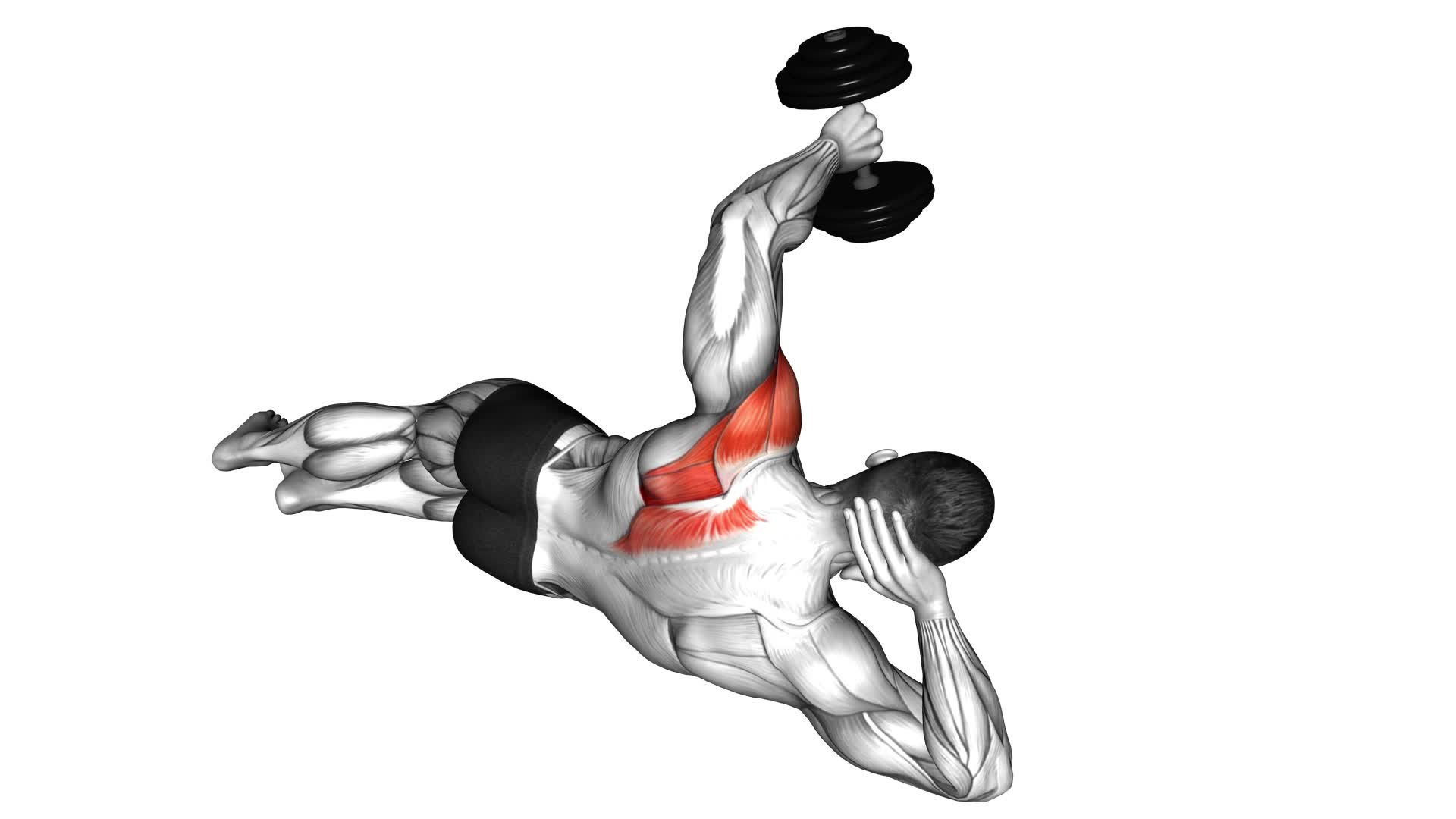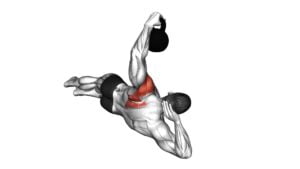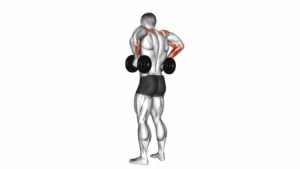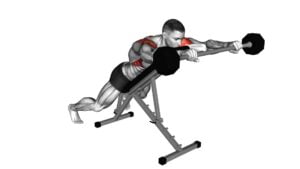Dumbbell Lying on Floor Rear Delt Raise – Video Exercise Guide & Tips

Are you looking for an effective exercise to target your rear deltoids? Look no further! The dumbbell lying on floor rear delt raise is here to help.
Watch This Exercise Video
This exercise is perfect for strengthening and toning your shoulders. With just a pair of dumbbells, you can easily perform this exercise at home or at the gym.
In this article, we'll guide you through the proper technique, common mistakes to avoid, and provide helpful tips to maximize your results.
Let's get started!
Key Takeaways
- Enhanced shoulder strength and stability
- Increased muscle activation in the rear deltoids
- Improved posture
- Reduced risk of shoulder injuries
Benefits of the Dumbbell Lying on Floor Rear Delt Raise
You'll experience enhanced shoulder strength and stability when incorporating the Dumbbell Lying on Floor Rear Delt Raise into your workout routine. This exercise offers several benefits, including increased muscle activation in the rear deltoids.
The rear deltoids are the muscles located at the back of your shoulders and play a crucial role in shoulder stability and overall upper body strength. By targeting and strengthening these muscles, you can improve your posture and reduce the risk of shoulder injuries.
The Dumbbell Lying on Floor Rear Delt Raise specifically targets the rear deltoids by isolating them and minimizing the involvement of other muscles. This isolation allows for a more focused and intense workout, leading to better muscle activation and development.
Additionally, this exercise helps to improve overall shoulder strength. Strong rear deltoids contribute to improved shoulder stability, which is essential for performing various upper body movements. Whether you're lifting weights, performing everyday tasks, or participating in sports, having strong and stable shoulders is crucial for optimal performance and injury prevention.
Incorporating the Dumbbell Lying on Floor Rear Delt Raise into your workout routine won't only enhance your shoulder strength and stability but also contribute to better overall upper body strength and posture. So, add this exercise to your routine to reap the benefits and enjoy a stronger, more stable upper body.
Equipment Needed for the Exercise
To properly perform the Dumbbell Lying on Floor Rear Delt Raise exercise, there are a few pieces of equipment that you'll need.
- First and foremost, you'll need a dumbbell of an appropriate weight for your fitness level.
- Additionally, it's recommended to have a mat or towel to lie on for added comfort and support during the exercise.
- If you don't have access to a dumbbell, you can also use alternative weights such as water bottles or resistance bands as substitutes.
Necessary Equipment for Exercise
To perform the Dumbbell Lying on Floor Rear Delt Raise exercise, you'll need specific equipment.
This exercise requires exercise equipment such as dumbbells or weights. The dumbbells should be of an appropriate weight that challenges your muscles without causing strain or discomfort. It's important to choose dumbbells that you can comfortably hold and control throughout the exercise.
Additionally, it's recommended to have a flat and stable surface, such as a gym mat or the floor, to lie on during the exercise. This will provide a secure and stable base for you to perform the movement.
Remember to always wear appropriate workout gear and ensure that the equipment you're using is in good condition for safe and effective exercise.
Recommended Exercise Accessories
To perform the Dumbbell Lying on Floor Rear Delt Raise exercise, you'll also benefit from using recommended exercise accessories. These exercise gear and workout accessories can enhance your workout experience and help you achieve better results.
Here are three items that can complement your Dumbbell Lying on Floor Rear Delt Raise exercise:
- Dumbbells: Choose dumbbells of appropriate weight to challenge your muscles and promote muscle growth.
- Exercise Mat: A comfortable and supportive exercise mat will provide a cushioned surface for your body to lie on during the exercise, ensuring a more comfortable and effective workout.
- Resistance Bands: Adding resistance bands to your Dumbbell Lying on Floor Rear Delt Raise exercise can help increase the intensity and target your rear deltoids even more.
Alternatives to Required Equipment
If you don't have access to the required equipment for the Dumbbell Lying on Floor Rear Delt Raise exercise, there are alternative options available. Instead of using dumbbells, you can try alternative exercises that target the rear deltoids using your bodyweight.
One option is the Reverse Snow Angels, where you lie face down on the floor and extend your arms out to the sides. Then, lift your arms up and down in a controlled manner, squeezing your shoulder blades together as you lift.
Another alternative is the Standing Wall Angels, where you stand with your back against a wall and slide your arms up and down along the wall, focusing on engaging your rear deltoids.
These bodyweight options can provide a similar workout for your rear deltoids without requiring any equipment.
Now, let's move on to the proper technique and form for the Dumbbell Lying on Floor Rear Delt Raise exercise.
Proper Technique and Form for the Exercise
When performing the Dumbbell Lying on Floor Rear Delt Raise exercise, make sure that you maintain proper technique and form throughout. This won't only maximize the benefits of the exercise but also help you avoid common mistakes that can lead to injury or ineffective results.
Here are some key tips to keep in mind:
- Start by lying face down on the floor with a dumbbell in each hand, palms facing inwards.
- Keep your arms straight and lift the dumbbells out to the sides, squeezing your shoulder blades together at the top of the movement.
- Lower the dumbbells back down slowly and repeat for the desired number of repetitions.
Benefits of proper form:
- Targets the rear delts, helping to improve posture and strengthen the upper back.
- Increases shoulder stability and mobility.
- Enhances overall upper body strength and muscle definition.
Common mistakes to avoid:
- Using too much weight, which can compromise form and lead to strain or injury.
- Raising the dumbbells too high, which shifts the focus away from the rear delts.
- Arching the back or lifting the head, which can strain the neck and lower back.
Common Mistakes to Avoid During the Exercise
One common mistake to avoid during the Dumbbell Lying on Floor Rear Delt Raise exercise is using excessive weight. While it may be tempting to go heavy, using too much weight can compromise your form and increase the risk of strain or injury. It's important to remember that this exercise is specifically designed to target the rear deltoid muscles, so using a weight that's too heavy can shift the focus onto other muscles and limit the effectiveness of the exercise.
Another common mistake to avoid is lifting the dumbbells too high. When performing the Dumbbell Lying on Floor Rear Delt Raise, it's crucial to maintain control and keep the movement within a comfortable range of motion. Lifting the dumbbells too high can put unnecessary strain on the shoulder joint and increase the risk of injury. Focus on lifting the dumbbells to a point where you feel a strong contraction in your rear deltoids, and then lower them back down slowly and controlled.
Lastly, it's important to maintain proper posture throughout the exercise. Avoid slouching or rounding your shoulders, as this can put strain on your neck and upper back. Keep your chest lifted, shoulders back, and engage your core for stability. By maintaining proper form techniques, you can maximize the effectiveness of the exercise and minimize the risk of injury.
Variations and Modifications for Different Fitness Levels
To modify the Dumbbell Lying on Floor Rear Delt Raise for different fitness levels, vary the weight used and adjust the range of motion. Here are some variations and modifications you can try:
- Lighter Weights: If you're a beginner or have limited upper body strength, start with lighter dumbbells or even just bodyweight. This will allow you to focus on proper form and technique before progressing to heavier weights.
- Increased Range of Motion: To challenge yourself and target your rear delts even more, you can increase the range of motion by extending your arms further behind you and lowering the dumbbells closer to the floor. This will provide a greater stretch and contraction in your rear delts.
- Resistance Bands: If you don't have access to dumbbells, you can use resistance bands instead. Simply secure the bands under your feet and hold the ends in your hands. The resistance bands will provide a similar effect as dumbbells, allowing you to work your rear delts effectively.
Tips for Getting the Most Out of the Exercise
To get the most out of the dumbbell lying on floor rear delt raise exercise, it's important to focus on proper form techniques. Keep your core engaged and your back flat on the ground to ensure effective muscle activation in your rear deltoids.
Additionally, make sure to control the movement and avoid using momentum to maximize the benefits of this exercise.
Proper Form Techniques
Get the most out of the Dumbbell Lying on Floor Rear Delt Raise exercise by maintaining proper form. To ensure you're performing this exercise correctly, follow these tips:
- Start by lying face down on the floor with a dumbbell in each hand, palms facing up.
- Keep your arms straight and lift the dumbbells off the floor by squeezing your shoulder blades together.
- As you lift the dumbbells, focus on engaging your rear delts by squeezing them at the top of the movement.
- Avoid using momentum or swinging your arms to lift the weights, as this can lead to improper form and reduced effectiveness.
- Remember to breathe steadily throughout the exercise and maintain control over the weights at all times.
Effective Muscle Activation
Maximize the effectiveness of the Dumbbell Lying on Floor Rear Delt Raise exercise by focusing on activating your rear delts throughout the movement. To ensure proper muscle recruitment and get the most out of this effective shoulder exercise, keep the following tips in mind:
- Engage your rear delts: Throughout the exercise, consciously contract your rear delts, the muscles at the back of your shoulders. This will help target and activate them effectively.
- Maintain proper form: Keep your back flat against the floor, and your chest lifted. Avoid using momentum or allowing your shoulders to roll forward, as this can shift the focus away from the rear delts.
- Control the movement: Slowly raise the dumbbells to shoulder level, and equally lower them back down. This controlled movement will engage the rear delts more efficiently.
Frequently Asked Questions
How Many Sets and Reps Should I Do for the Dumbbell Lying on Floor Rear Delt Raise?
To determine the number of sets and reps for the dumbbell lying on floor rear delt raise, consider your fitness goals and current strength level.
Start with 2-3 sets of 10-12 reps and gradually increase as you get stronger.
Remember, there are variations of this exercise that you can explore to target different muscles.
It's always a good idea to consult with a fitness professional to create a tailored program that suits your needs.
Can I Use a Resistance Band Instead of Dumbbells for This Exercise?
Yes, you can use a resistance band instead of dumbbells for the dumbbell lying on floor rear delt raise exercise. Using a resistance band provides an alternative way to target your rear deltoid muscles.
However, it's important to note that using dumbbells offers additional benefits such as increased resistance and the ability to progressively overload the muscles.
Incorporating dumbbells into your workout routine can help you build strength and muscle mass more effectively.
Should I Perform This Exercise at the Beginning or End of My Workout?
When it comes to the beginning vs. end debate in exercise order guidelines, it's important to consider your goals and priorities.
Starting with the Dumbbell Lying on Floor Rear Delt Raise can activate and warm up your rear deltoids, preparing them for more intense exercises.
However, if your main focus is on building strength, you may want to save this exercise for the end when your muscles are fatigued.
Ultimately, it's up to you to decide what works best for your workout routine.
Can I Do This Exercise if I Have a Shoulder Injury?
If you have a shoulder injury, it's important to modify your exercises to avoid further damage. Instead of doing the Dumbbell Lying on Floor Rear Delt Raise, consider alternative exercises that target the same muscles without putting strain on your shoulders.
Consult with a medical professional or a certified trainer to find the best shoulder injury modifications and alternative exercises that suit your specific needs and limitations.
Are There Any Other Exercises That Target the Rear Delts That I Can Incorporate Into My Routine?
If you're looking for alternative exercises to target your rear delts, there are a few options you can incorporate into your routine. Bent-over dumbbell rows and face pulls are both great options that specifically target the rear delts.
Conclusion
In conclusion, the dumbbell lying on floor rear delt raise is a beneficial exercise for targeting the rear delts. It requires minimal equipment and can be modified for different fitness levels.
By maintaining proper technique and form and avoiding common mistakes, you can maximize the effectiveness of this exercise.
Incorporating this exercise into your routine, along with following the tips provided, will help you achieve optimal results for your rear delt muscles.

Author
Years ago, the spark of my life’s passion ignited in my mind the moment I stepped into the local gym for the first time. The inaugural bead of perspiration, the initial endeavor, the very first surge of endorphins, and a sense of pride that washed over me post-workout marked the beginning of my deep-seated interest in strength sports, fitness, and sports nutrition. This very curiosity blossomed rapidly into a profound fascination, propelling me to earn a Master’s degree in Physical Education from the Academy of Physical Education in Krakow, followed by a Sports Manager diploma from the Jagiellonian University. My journey of growth led me to gain more specialized qualifications, such as being a certified personal trainer with a focus on sports dietetics, a lifeguard, and an instructor for wellness and corrective gymnastics. Theoretical knowledge paired seamlessly with practical experience, reinforcing my belief that the transformation of individuals under my guidance was also a reflection of my personal growth. This belief holds true even today. Each day, I strive to push the boundaries and explore new realms. These realms gently elevate me to greater heights. The unique combination of passion for my field and the continuous quest for growth fuels my drive to break new ground.







